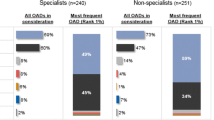Abstract
Early intensive therapy in type 2 diabetes can prevent complications. Nevertheless, metabolic control is often sub-optimal in newly diagnosed patients. This web-based survey aimed to evaluate opinions of physicians about treatment, priorities, and barriers in the care of patients first referred to diabetes clinics. Data on physician attitudes toward therapeutic preferences for two clinical case models (same clinical profile, except HbA1c levels of 8.6 and 7.3% at the first access, respectively) were collected. Participants were asked to rank from 1 (most important) to 6 (least important) a list of priorities and barriers associated with the care of new patients. Overall, 593 physicians participated. In both case models, metformin and education were primary options, although their combination with other classes of drugs varied substantially. Main priorities were “to teach the patient how to cope with the disease” and “to achieve HbA1c target”; main barriers were “lack of time” and “long waiting list”. At multivariate analyses, physicians from the South of Italy had a twofold higher likelihood to attribute a rank 1–2 to organizational barriers than those operating in the North (South vs. North: OR: 2.4; 95% CI 1.4–4.1; Center vs. North: OR: 2.4; 95% CI 0.9–3.2). In the absence of a widely accepted evidence-based therapeutic algorithm driving the therapeutic choices according to the patient characteristics, prescriptions vary according to physician preferences. Education is perceived as a key-strategy, but organizational barriers and geographic disparities are an obstacle. These findings can drive new strategies to reduce clinical inertia, attitudes variability, and geographic disparities.
Similar content being viewed by others
References
The Diabetes Control and Complications Trial/Epidemiology of Diabetes Interventions and Complications (DCCT/EDIC) Study Research Group (2005) Intensive diabetes treatment and cardiovascular disease in patients with type 1 diabetes. N Engl J Med 353:2643–2653
Holman RR, Sanjoy KP, Bethel MA, Matthews DR, Neil HAW (2008) 10-Year follow-up of intensive glucose control in type 2 diabetes. N Engl J Med 359:1577–1589
Gæde P, Lund-Andersen H, Parving HH, Pedersen O (2008) Effect of a multifactorial intervention on mortality in type 2 diabetes. N Engl J Med 358:580–591
Ceriello A, Ihnat MA, Thorpe JE (2009) Clinical review 2: the “metabolic memory”: is more than just tight glucose control necessary to prevent diabetic complications? J Clin Endocrinol Metab (United States) 94(2):410–415
Ihnat MA, Thorpe JE, Ceriello A (2007) Hypothesis: the ‘metabolic memory’, the new challenge of diabetes. Diabet Med 24:582–586
De Micheli A (2008) Italian standards for diabetes mellitus 2007: executive summary. Diabete Italia, AMD Associazione Medici Diabetologi, SID Società Italiana di Diabetologia. Acta Diabetol 45:107–127
Cimino A, Fava D, Giorda C, Meloncelli I, Nicolucci A, Pellegrini F, Rossi MC, Turco S, Vespasiani G (2010) AMD Annals: quality indicators in diabetes care in Italy. Kino, Turin, Italy http://www.infodiabetes.it/pages/annali_amd/. Last access 27 April 2011
Grant R, Adams AS, Trinacty CM, Zhang F, Kleinman K, Soumerai SB, Meigs JB, Ross-Degnan D (2007) Relationship between patient medication adherence and subsequent clinical inertia in type 2 diabetes glycemic management. Diabetes Care 30:807–812
Ziemer DC, Miller CD, Rhee MK, Doyle JP, Watkins C Jr, Cook CB, Gallina DL, El-Kebbi IM, Barnes CS, Dunbar VG, Branch WT Jr, Phillips LS (2005) Clinical inertia contributes to poor diabetes control in a primary care setting. Diabetes Educ 31:564–571
Shah BR, Hux JE, Laupacis A, Zinman B, van Walraven C (2005) Clinical inertia in response to inadequate glycemic control: do specialists differ from primary care physicians? Diabetes Care 28:600–606
Brown JB, Nichols GA, Perry A (2004) The burden of treatment failure in type 2 diabetes. Diabetes Care 27:1535–1540
Knecht LA, Gauthier SM, Castro JC, Schmidt RE, Whitaker MD, Zimmerman RS, Mishark KJ, Cook CB (2006) Diabetes care in the hospital: is there clinical inertia? J Hosp Med 1:151–160
Phillips LS, Branch WT, Cook CB, Doyle JP, El-Kebbi IM, Gallina DL, Miller CD, Ziemer DC, Barnes CS (2001) Clinical inertia. Ann Intern Med 135:825–834
Nathan DM, Buse JB, Davidson MB, Ferrannini E, Holman RR, Sherwin R, Zinman B, American Diabetes Association, European Association for the Study of Diabetes (2009) Medical management of hyperglycaemia in type 2 diabetes mellitus: a consensus algorithm for the initiation and adjustment of therapy: a consensus statement from the American Diabetes Association and the European Association for the Study of Diabetes. Diabetologia 52:17–30
Schernthaner G, Barnett AH, Betteridge DJ, Carmena R, Ceriello A, Charbonnel B, Hanefeld M, Lehmann R, Malecki MT, Nesto R, Pirags V, Scheen A, Seufert J, Sjohölm A, Tsatsoulis A, DeFronzo R (2010) Is the ADA/EASD algorithm for the management of type 2 diabetes based on evidence or opinion? A critical analysis. Diabetologia 53:1258–1269
Ciardullo AV, Daghio MM, Bevini M, Feltri G, Novi D, Fattori G, Borsari S, Donato CD (2010) Joint and distinct risk factors associated with micro- and macrovascular complications in a cohort of type 2 diabetic patients cared through disease management. Acta Diabetol 47:301–308
Gois CJ, Ferro AC, Santos AL, Sousa FP, Ouakinin SR, do Carmo I, Barbosa AF (2010) Psychological adjustment to diabetes mellitus: highlighting self-integration and self-regulation. Acta Diabetol [Epub ahead of print]
Zanuso S, Jimenez A, Pugliese G, Corigliano G, Balducci S (2010) Exercise for the management of type 2 diabetes: a review of the evidence. Acta Diabetol 47:15–22
Mendes AB, Fittipaldi JA, Neves RC, Chacra AR, Moreira ED Jr (2010) Prevalence and correlates of inadequate glycaemic control: results from a nationwide survey in 6,671 adults with diabetes in Brazil. Acta Diabetol 47:137–145
Costi M, Dilla T, Reviriego J, Castell C, Goday A (2010) Clinical characteristics of patients with type 2 diabetes mellitus at the time of insulin initiation: INSTIGATE observational study in Spain. Acta Diabetol 47(Suppl 1):169–175
Author information
Authors and Affiliations
Corresponding author
Rights and permissions
About this article
Cite this article
Suraci, C., Mulas, F., Rossi, M.C. et al. Management of newly diagnosed patients with type 2 diabetes: what are the attitudes of physicians? A SUBITO!AMD survey on the early diabetes treatment in Italy. Acta Diabetol 49, 429–433 (2012). https://doi.org/10.1007/s00592-012-0374-5
Received:
Accepted:
Published:
Issue Date:
DOI: https://doi.org/10.1007/s00592-012-0374-5




